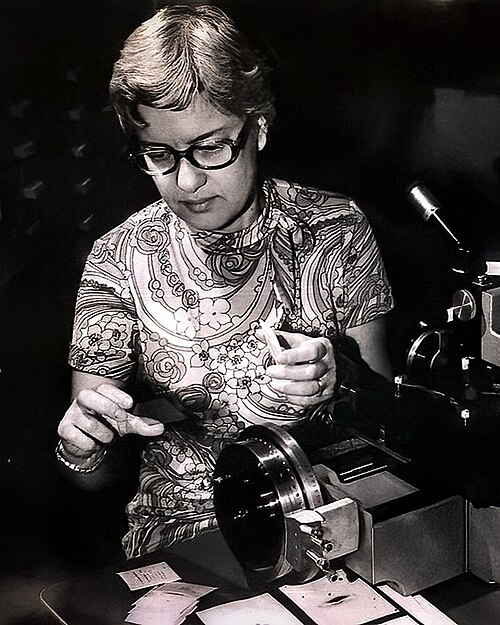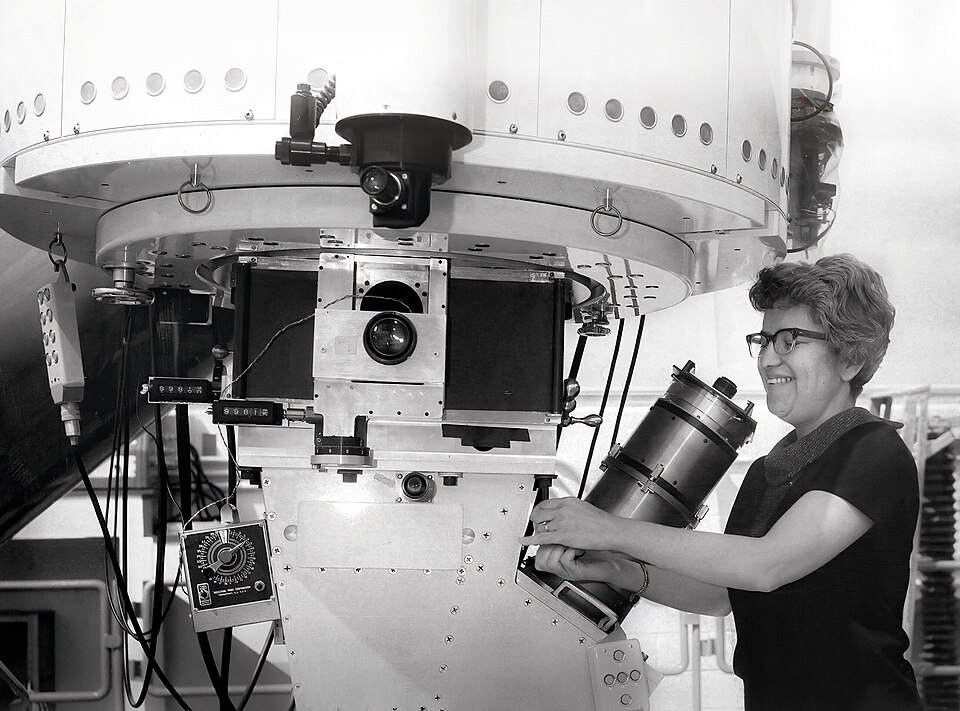
When astronomer Vera Rubin found groundbreaking evidence of dark matter in the 1970s, the idea of its existence went against the known laws of the universe at the time. Today, scientists know that dark matter makes up around 84% of the universe. In celebration of Rubin’s birthday, let’s explore her life and legacy.
Lifelong Astronomer
Vera Florence Cooper Rubin was born on July 23, 1928, in Philadelphia, Pennsylvania. She was born into a family of Eastern European immigrants. Her father, Pesach Kobchefski, immigrated from Lithuania at age seven and later anglicized his name to Philip Cooper. Her mother, Rose Applebaum, was the daughter of immigrants from Bessarabia (a historical region now made up by parts of Moldova and Ukraine). When Rubin was 10 years old, the family moved to Washington, D.C., and Rubin’s curiosity in astronomy blossomed as she watched the stars from the window of her new home. This interest inspired Rubin to build a makeshift cardboard telescope with her father and start learning how to observe and track meteors.

Vera Rubin measuring spectra at the Carnegie Institution in Washington, D.C. in 1974. Licensed for use in the public domain by Wikimedia Commons.
After high school, Rubin attended Vassar College to study astronomy. She was the only astronomy graduate when she received her bachelor’s degree in 1948. She attempted to pursue graduate studies at Princeton University, but its astronomy department excluded women until 1975. She ended up at Cornell University, where her fiancé Bob Rubin was studying physics. At the time, Cornell’s astronomy department was made up of only four members, but it had a robust physics department with professors who went on to win a Nobel Prize.
On the Brink of Discovery
Rubin began studying galactic dynamics and the motions of galaxies while at Cornell. Her early work laid the foundation for her future discoveries on the subject. She made one of the first observations of deviations from Hubble flow — the idea that the farther away a galaxy is from Earth, the faster it moves. Some of her original conclusions were eventually disproven; however, the idea that galaxies were moving has proven true and was a significant observation. She presented these ideas and the data she’d gathered at an American Astronomical Society meeting in 1950. Her presentation was controversial, as her evidence wasn’t completely supported and she wasn’t a member of the society. She later recalled that her talk had received negative feedback (Ref. 1), and her paper was never published.
After completing her master’s degree in 1951, Rubin went to Georgetown University to earn her PhD. Her dissertation theorized that galaxies were clumped together, as opposed to being randomly distributed throughout the universe. This theory was controversial at the time and didn’t gain much traction in the astronomy world for another two decades. After a few brief stints in different academic positions, she joined the Department of Terrestrial Magnetism at the Carnegie Institution of Science as a staff member in 1965. She began working with Kent Ford, an astronomer who was working with a state-of-the-art spectrometer — an instrument that separates, measures, and analyzes light. Ford’s device was the most sensitive spectrometer at the time, allowing them to hone in on small sections of galaxies. The instrument measured the Doppler effect, or when the wavelength shift is proportional to the speed of the light source, across galaxies. The pair continued to work together over the years, with their combined research leading to significant discoveries.

Vera Rubin operating a telescope with Kent Ford’s spectrograph at Kitt Peak National Observatory in 1963. Licensed under Creative Commons Attribution 4.0 International via Wikimedia Commons.
Mysterious Matter
By the late 1970s, Rubin and Ford had studied more than 60 galaxies, and it was then that something critical in their Doppler observations stuck out to them. They noticed that the stars at the outer edges of the galaxies were moving at the same speed as those at the center. This went against the known laws of physics, as Newton’s Laws of Motion would say that the galaxies should have been flying apart from the mass of the matter. Since the core region of a spiral galaxy has the highest concentration of visible stars, science laws would assume that the majority of the mass — and gravity — would also be concentrated at its center, meaning that the farther away a star is from the center, the slower it would rotate. It was clear that there had to be some invisible mass that was holding the galaxies together, causing them to rotate at such a high velocity. This invisible mass was dark matter.
The existence of dark matter had been proposed and dismissed by the scientific community before. In 1933, Swiss astronomer Fritz Zwicky used the Doppler effect to observe galaxies within the Coma cluster and came to the same conclusion that there must be an invisible mass binding the galaxies together within the cluster. Zwicky’s theory wasn’t taken seriously by his colleagues, but he turned out to be ahead of his time. Rubin also faced initial skepticism from her colleagues, but it was hard to dispute her scientific evidence of the invisible mass.
It’s now known that around 84% of all matter in the universe is made up of dark matter, which aligns with Rubin’s calculations that galaxies must contain about 10 times as much mass as is accounted for in visible stars. It’s also known that the effects of dark matter reach throughout every part of the universe, affecting how stars move, how galaxies interact with each other, and how matter forms masses. However, although the study of dark matter has become its own field in astronomy and much has been learned about it, it’s still not fully understood. To quote Astronomy magazine, “[Dark matter] is to the cosmos like air is to humans: ubiquitous, necessary, unseen but felt” (Ref. 1). NASA also describes dark matter as a “mysterious substance” (Ref. 2), as scientists today are still studying it to fully understand what it’s made up of.
Rubin’s Legacy Lives On
Rubin continued her astronomical research following the breakthrough with dark matter, publishing more than 100 scientific papers. She remained at the Carnegie Institute until she retired in 2014 as a senior fellow of astronomy. She balanced a prolific career with raising four children, all of whom went on to earn PhDs in science or math. She and her husband Robert were together until his death in 2008.
Rubin received many awards and honors in her lifetime, including being the second woman ever elected to the National Academy of Sciences in 1981, receiving the National Medal of Science in 1993, and being the second woman to receive the Gold Medal of the Royal Astronomical Society in London in 1996. Many scientists consider it an “egregious snub” (Ref. 3) that Rubin was never nominated for a Nobel prize, given how much of an impact the discovery of dark matter has had in the field of astronomy. She has continued to receive recognition posthumously since her death in 2016 at age 88. In 2019, the Large Synoptic Survey Telescope was renamed the Vera C. Rubin Observatory and is used to continue the study of dark matter.
Rubin was also selected to appear on a 2025 special edition coin by U.S. Mint, which is a U.S. government agency that produces coins used as currency. This special edition program takes place every four years and honors the achievements of inspiring American women.
Further Reading
- Learn more about Rubin’s life and the importance of dark matter:
- Check out other astronomers on the COMSOL blog:
- Caroline Herschel, the only woman before Rubin to receive a Gold Medal of the Royal Astronomical Society
- Henrietta Swan Leavitt, whose work as a “human computer” paved the way for the discovery that our universe is expanding
- Subrahmanyan Chandrasekhar, who challenged existing theories about white dwarf stars and rewrote our understanding of stellar evolution
References
- S. Scoles, “How Vera Rubin confirmed dark matter,” Oct. 4; https://www.astronomy.com/science/how-vera-rubin-confirmed-dark-matter/
- “Building Blocks,” Oct. 22; https://science.nasa.gov/universe/overview/building-blocks/#dark-matter
- E. Siegel, “Who Really Discovered Dark Matter: Fritz Zwicky or Vera Rubin?” August 2021; https://www.forbes.com/sites/startswithabang/2021/08/24/who-really-discovered-dark-matter-fritz-zwicky-or-vera-rubin/



Comments (0)